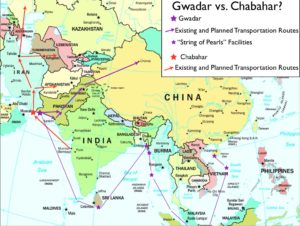By Gaurav Dixit
When the first Indian shipment of wheat left Kandla port for Chabahar port in Iran, and then over land via Iran into Afghanistan, India silently sent multiple strong yet subtle messages to its allies and opponents across the region. The foremost being its commitment towards Afghanistan.
Development of the alternative inland transit route to Afghanistan via Iran is one of the major components of India’s growing role in the region, and an add-on to its existing tools to exercise its combination of economic and soft power.
The achievement is unique, particularly in the context of the changing contours of conflict in the region; its geopolitical impact and India’s continuous strategic and diplomatic endeavour to counter it.
Even a cursory look at events of the last few months suggests that India had its own share of strained relations with Iran over various issues, including an impasse on awarding the Farzad B gas field to it. India clearly told the National Iranian Oil Co (NIOC) about its plans to cut oil imports by a fifth to 190,000 barrels per day (bpd) from 240,000 bpd. In response, Iran threatened to cut the subsidy it provides to Indian buyers.
Similarly, India has been wary of the growing ties between Iran and China on the one hand and Iran and Pakistan on the other. However all these problems have neither influenced India’s commitment to develop the Chabahar port, nor did India allow these differences to spiral to a point where India-Iran cooperation would have been impossible.
Additionally, at the regional level, India has been able to achieve a balance between its friends, by keeping itself distant from their inter-personal tensions; further, it has not allowed the state of their inter-personal relations to dictate policy choices to India, particularly its plan to build Chabahar port and provide an alternative route to Afghanistan. The textbook case is the growing tension between Iran and the USA, and the growing bonhomie between Saudi Arabia and the US.
US Secretary of State Rex Tillerson, during his visit to India, discussed greater cooperation between India and the US in Afghanistan. However, the growing tension between the US and Iran, and Washington’s strong inclination towards Saudi Arabia in recent months has been a major source of concern for India.
As far as US-Iran relations go, each time their relations have soured in the past, the US has asked India to cut its oil and gas import from Iran, after imposing economic sanctions on Iran to disrupt its nuclear Programme.
India–Saudi relations have never been “too-good-too-bad”. However, Saudi Arabia had, in the past, indicated its reservations over India building the Iranian port as it felt that development of the Chabahar port would lead to massive development and revenue generation for Iran, ultimately helping it to push its influence in the Gulf and the Indian Ocean region. Growing Iranian influence in the region would certainly go against its interest in West Asia where it has always tried hard to counter Iranian influence over the centuries old Shia-Sunni schism. There was a slight apprehension that the Saudis might use the US leverage over India to throttle the development of Chabahar port.
Pakistan, which has been wary of any kind of Indian engagement in Afghanistan, has never been comfortable with the project. Two prominent reasons for its discomfort are that it would allow India not only to gain strategic depth into Afghanistan but also to cement its ties with Iran. Also Chabahar port is considered by both Chinese and Pakistani experts as a counter weight to Gwadar port, built by the former in Balochistan in Pakistan. In order to deprive India of any strategic gain in Afghanistan, Pakistan denied India a direct land transit route through it, the shortest and most economical path for India to Afghanistan and Central Asia.
Therefore, operationalization of the Chabahar port is considered a setback for Pakistan which, by denying India a land transit route, sought to maintain the hegemonic strategic space for itself.
Similarly China, which shares strong economic ties with both Pakistan and Iran, had never been comfortable with the project, though it never opposed the project. For Beijing, the Chabahar port is the tip of the iceberg of India’s geostrategic ambitions. A report in the Global Times puts Chinese apprehension in perspective by claiming the project is part of India’s comprehensive plan to shape India’s geopolitics to the northwest and extend its influence further into the Middle East, Central Asia and the Trans-Caucasus.
The primary propellant for Chinese discomfort may actually not be India’s aim to gain comprehensive ground in Central Asia and West Asia, but in India’s enhanced engagement in the Indian Ocean to counter Chinese growing clout. It is widely expected that the epicentre of the India-China rivalry will be in the Indian Ocean; and this is where the strategic importance of Gwadar and Chabahar lies respectively for both sides.
The smooth ongoing development work of Chabahar port and the shipment of the first batch of 1.1 million tonnes of wheat suggest that India has been able to persuade its friends and sceptics about the overwhelming positive impact of the project in the region. It has been able to convince the US about the need for India to have a good relationship with Iran. With the decline in the number of somber statements from the Saudis, it appears India has been able to assuage Riyadh’s fear of the unchecked rise of Iran.
What is evident is that India is capable of negotiating and formulating its own foreign policy, at least its developmental policy, without the political interventions of countries like Saudi Arabia, Russia and the USA.

